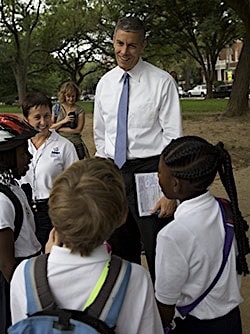U.S. Secretary of Education Arne Duncan joined more than a hundred students and their parents on a “walking school bus” ride through Washington, D.C., to promote safe and healthy lifestyles. Now, if only he could also ride a school bus.
D.C. Mayor Adrian Fenty, Chancellor of Schools Michelle Rhee and U.S. Federal Highway Administrator Victor Mendez walked with Duncan and the students along a two-block route from Lincoln Park to Maury Elementary. The “Walking School Bus” event was intended to promote the importance of safe, healthy lifestyles, as well as welcoming students back to school, according to a Department of Education spokesperson. Maury Elementary’s initiative is part of its local Safe Routes to School Program, a federal effort administered by the U.S. Department of Transportation to encourage more students to walk and bicycle to school. The event also highlighted AAA’s School Safety Patrol program which has been helping get students safely to and from America’s schools for 90 years.
Tuesday’s event follows First Lady Michelle Obama’s “Let’s Move” initiative aimed at confronting the problem of childhood obesity through fitness and adequate nutrition.
Meanwhile, the Department of Education is apparently readying the rollout of a survey aimed at creating a better snapshot of school busing nationwide and how it affects student learning, according to sources in Washington, D.C. NHTSA is also preparing its own public awareness campaign touting the advantages of the school bus. Walking and biking definitely have their health benefits, but school buses are additional options to help students get to school safetly, especially as the feds recognize school buses as the safest vehicle on the road.
But school buses can also provide a cost-efficient service to parents, saving gas money and time. The American School Bus Council says that one 54-passenger school bus, fully loaded with students, mind you, can replace up to 36 passenger cars and trucks that normally would be used by parents and others to take kids to and from school.
Plus, after all, if kids can’t get to school in the first place, how are they to learn? School buses also fit that bill. Duncan also taking time to recognize school buses would be especially timely as a federal judge recently ended the federal government’s receivorship of D.C.’s special education transportation program, returing it to the district, which is currently working with school transportation industry professionals on fixing troubles of the past.
This has been a major initiative of the ASBC, which succeeded earlier this year in sitting down with Kevin Jennings, the assistant deputy secretary of education and the head of the department’s Office of Safe and Drug-Free Schools. Jennings is especially targeting student bullying, and, according to the ASBC, he recognizes school buses as an extension of the classroom. Jennings is scheduled to speak this fall at the NAPT annual conference in Portland on this very topic.
So, perhaps, should more traction be gained in making the connection between the school bus and the classroom, perhaps next year Secretary Duncan will indeed entertain the idea of riding a D.C. school bus, which service the district’s special education population. This is just a thought, but I think this could go a long way in telling the other side of the story when it comes to school transportation.
















